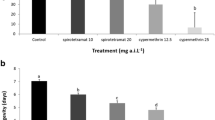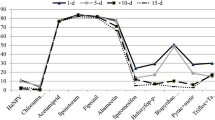Abstract
Spirotetramat is a new systemic insecticide listed in Group 23 of the IRAC mode-of-action classification scheme as an inhibitor of lipid biosynthesis. Side effects assessment on key natural enemies is necessary before incorporating a pesticide in IPM programs. Herein, lethal and sublethal side effects of spirotetramat on adults and larvae of Cryptolaemus montrouzieri Mulsant (Coleoptera: Coccinellidae) were evaluated under laboratory conditions by topical application and by ingestion of treated individuals of Planococcus citri Risso (Hemiptera: Pseudococcidae). The lethal and sublethal effects of spirotetramat were compared to those of chlorpyriphos and pyriproxyfen, two insecticides commonly used in Spanish citrus. Spirotetramat resulted harmless: (1) when directly applied on larvae and adults of C. montrouzieri, since it did not affect survival, longevity, fecundity, egg hatching, and offspring survival. In contrast, chlorpyriphos was classified as moderately toxic for adults due to its effects on fecundity, egg hatching and offspring survival. Pyriproxyfen was classified as harmful for larvae due to the acute effect on pupal mortality. When larvae and adults of C. montrouzieri were fed with treated prey, spirotetramat was also classified as harmless. Adults of C. montrouzieri fed with pyriproxyfen-treated prey exhibited increased fecundity but no eggs hatched. Moreover, the larvae fed on pyriproxyfen-treated prey did not reach the adult stage. The results of this study indicate that spirotetramat may be compatible with augmentative releases of C. montrouzieri in citrus.

Similar content being viewed by others
References
Abad-Moyano R, Pina T, Dembilio O, Ferragut F, Urbaneja A (2009) Survey of natural enemies of spider mites (Acari: Tetranychidae) in citrus orchards in eastern Spain. Exp Appl Acarol 47:49–61
Abbott WS (1925) A method of computing the effectiveness of an insecticide. J Econ Entomol 18:265–267
Alvis-Dávila L, Raimundo A, Villalba M, García-Marí F (2002) Identificación y abundancia de coleópteros coccinélidos en los cultivos de cítricos valencianos. Bol San Veg Plagas 28:479–491
Bayer Crop Science (2012) Spirotetramat (Movento, Ultor, Tihan). http://www.bayercropscience.com/bcsweb/cropprotection.nsf/id/spirotetramat.htm. Accessed 10 March
Bellows TS, Morse JG (1988) Residual toxicity following dilute or low-volume applications of insecticides used for control of California red scale (Homoptera: Diaspididae) to four beneficial species in a citrus agroecosystem. J Econ Entomol 81:892–898
Boyero JR, Rodríguez N, Suria R, Ruíz R, Pascual F (2005) Efectos de varios plaguicidas sobre Cryptolaemus montrouzieri Mulsant y Rhyzobius lophantae Blaisdell (Coleoptera, Coccinellidae). Bol San Veg Plagas 31:79–87
Brück E, Elbert A, Fischer R, Krueger S, Kühnhold J, Klueken AM, Nauen R, Niebes JF, Reckmann U, Schnorbach HJ, Steffens R, Van Waetermeulen X (2009) Movento an innovative ambimobile insecticide for sucking insect pest control in agriculture: biological profile and field performance. Crop Prot 28:838–844
Castañer M (1992) Análisis de la incidencia de diversos plaguicidas en tres insectos utilizados en la lucha biológica: Cryptolaemus montrouzieri Mulsant, Lysiphlebus testaceipes (Cresson) y Encarsia formosa Gahan. Ph.D. Thesis. Facultad de Ciencias Biológicas. Universidad de Valencia
Cloyd RA, Dickinson A (2006) Effect of insecticides on mealybug destroyer (Coleoptera: Coccinellidae) and parasitoid Leptomastix dactylopii (Hymenoptera: Encyrtidae), Natural enemies of citrus mealybug (Homoptera: Pseudococcidae). J Econ Entomol 99:1596–1604
Croft BA (1990) Arthropod biological control agents and pesticides. Wiley, New York
Daane KM, Sime KR, Fallon J, Cooper M (2007) The impact of Argentine ants on mealybugs and their natural enemies in California’s coastal vineyards. Ecol Entomol 32:583–596
Desneux N, Decourtye A, Delpuech JM (2007) The sublethal effects of pesticides on beneficial arthropods. Ann Rev Entomol 52:81–106
EC (2009) Directive 2009/128/EC of the European Parliament and of the Council of 21 October 2009 establishing a framework for Community action to achieve the sustainable use of pesticides. OJEU L 309:71–86
Franco JC, Suma P, Borges da Silva E, Blumberg D, Mendel Z (2004) Management strategies of mealybug pests of citrus in Mediterranean countries. Phytoparasitica 32:507–522
Galvan TL, Koch RL, Hutchison WD (2005) Effects of spinosad and indoxacarb on survival, development, and reproduction of the multicolored Asian lady beetle (Coleoptera: Coccinellidae). Biol Control 34:108–114
Grafton-Cardwell EE, Gu P (2003) Conserving vedalia beetle, Rodolia cardinalis (Mulsant) (Coleoptera: Coccinellidae), in citrus: a continuing challenge as new insecticides gain registration. J Econ Entomol 96:1388–1398
Grafton-Cardwell EE, Scott SJ (2008) Efficacy of acaricides for control of citrus red mite. Arthropod Manage Tests, vol 33, (D5). Entomological Society of America, Lanham
Grafton-Cardwell EE, Reagan CA, Haviland DR (2007) Efficacy of Movento to control California red scale, 2006. Arthropod Manage Tests, vol 32 (D6). Entomological Society of America, Lanham
Hagen KS, Mills NJ, Gordh G, McMurtry JA (1999) Terrestrial arthropod predators of insects and mite pests. In: Bellows TS, Fisher TW (eds) Handbook of biological control. Principles and applications of biological control. Academic Press, San Diego, pp 383–504
Hassan SA (1998) Introduction to standard characteristics of test methods. In: Haskell PT, McEwen P (eds) Ecotoxicology: pesticides and beneficial organisms. Kluwer Academic Publishers, Dordrecht, NL, pp 55–68
Hattingh V, Tate B (1995) Effects of field-weathered residues of insect growth regulators on some Coccinellidae (Coleoptera) of economic importance as biocontrol agents. Bull Entomol Res 85:489–493
IRAC (2012) Resistance management for sustainable agriculture and improved public health. http://www.irac-online.org. Accessed 10 March 2012
Jacas JA, Urbaneja A (2010) Biological control in citrus in Spain: from classical to conservation biological control. In: Ciancio A, Mukerji KG (eds) Integrated management of arthropod pests and insect borne diseases. Integrated management of plant pests and diseases. Springer, Dordrecht, pp 61–72
Jacas JA, Urbaneja A, Viñuela E (2006) History and future of introduction of exotic arthropod biological control agents in Spain: a dilemma? Biocontrol 51:1–30
Katsoyannos P (1997) Status and importance of Rhyzobius forestieri (Col.: Coccinellidae) on citrus at Chios Island, Greece, nine years after its introduction. Entomophaga 42:387–392
Mansour R, Suma P, Mazzeo G, Lebdi GK, Russo A (2011) Evaluating side effects of newer insecticides on the vine mealybug parasitoid Anagyrus sp. near pseudococci, with implications for integrated pest management in vineyards. Phytoparasitica 39:369–376
MARM (2012) Ministerio de Medio Ambiente y Medio Rural y Marino. Registro de productos fitosanitarios. http://www.magrama.es/es/agricultura/temas/medios-de-produccion/productos-fitosanitarios/registro/menu.asp. Accessed 10 March 2012
Martínez-Ferrer MT, Grafton-Cardwell EE, Shorey HH (2003) Disruption of parasitism of the California red scale (Homoptera: Diaspididae) by three ant species (Hymenoptera: Formicidae). Biol Control 26:279–286
Mendel Z, Blumberg D, Ishaaya I (1994) Effects of some insect growth regulators on natural enemies of scale insects (Horn.: Coccoidea). Entomophaga 39:199–209
Michelena JM, Sanchis A (1997) Evolución del parasitismo y fauna útil sobre pulgones en una parcela de cítricos. Bol San Veg Plagas 23:241–255
Moens J, De Clercq P, Tirry L (2011) Side effects of pesticides on the larvae of the hoverfly Episyrphus balteatus in the laboratory. Phytoparasitica 39:1–9
Moens J, Tirry L, De Clercq P (2012) Susceptibility of cocooned pupae and adults of the parasitoid Microplitis mediator to selected insecticides. Phytoparasitica 40:5–9
Muştu M, Kilinçer N, Ülgentürk S, Kaydan MB (2008) Feeding behavior of Cryptolaemus montrouzieri on mealybugs parasitized by Anagyrus pseudococci. Phytoparasitica 36(4):360–367
Nauen R, Reckmann U, Thomzik J, Thielert W (2008) Biological profile of spirotetramat (Movento®) a new two-way systemic (ambimobile) insecticide against sucking pest species. Bayer CropScience Journal 61:245–278
Pascual-Ruiz S, Urbaneja A (2006) Lista de efectos secundarios de plaguicidas sobre fauna útil en cítricos. Levante Agrícola 380:186–191
Schnorbach J, Elbert A, Laborie B, Navacerrada J, Bangels E, Gobin B (2008) Movento®, an ideal tool for integrated pest management in pomefruit, citrus and vegetables. Bayer CropScience J 61:377–402
Smith D, Beattie GAC, Broadley R (1997) Citrus pests and their natural enemies: integrated pest management in Australia. Queensland Department of Primary Industries, Brisbane
Sterk G, Hassan SA, Baillod M, Bakker F, Bigler F, Blümel S (1999) Results of the seventh joint pesticide testing programme carried out by the IOBC/WPRS Working Group ‘Pesticides and Beneficial Organisms’. Biocontrol 44:99–117
Tena A, Catalán J, Vanaclocha P, Urbaneja P, Jacas JA, Urbaneja A (2011) Evaluación de distintas estrategias de manejo químico del piojo rojo de California, Aonidiella aurantii (Maskell). Levante Agrícola 404:44–48
Urbaneja A, Pascual-Ruiz S, Pina T, Abad-Moyano R, Vanaclocha P, Montón H, Castañera P, Dembilio O, Jacas JA (2008) Efficacy of some acaricides against Tetranychus urticae (Acari: Tetranychidae) and their side-effects on selected natural enemies occurring in citrus orchards. Pest Manag Sci 64:834–842
Urbaneja A, Catalán J, Tena A, Jacas JA (2012) Gestión Integrada de Plagas de Cítricos. http://gipcitricos.ivia.es. Accessed 10 March 2012
UC [University of California] (1991) Integrated pest management for citrus. UC - Statewide IPM project. Division of Agriculture and Natural Resources, Publication No. 3303, Oakland, CA
Vacas S, Vanaclocha P, Alfaro C, Primo J, Verdú MJ, Urbaneja A, Navarro-Llopis V (2012) Mating disruption for the control of Aonidiella aurantii Maskell (Hemiptera: Diaspididae) may contribute to increased effectiveness of natural enemies. Pest Manag Sci 68:142–148
Acknowledgments
We are grateful to Ramón Aparici and Alberto García (Insectario GVA) for maintenance of insect colonies. This research was partly funded by Conselleria d’Agricultura, Pesca i Alimentació from Generalitat Valenciana, the Spanish Ministry of Science and Innovation (Projects: AGL2008-05287-C04/AGR and AGL2011-30538-C03/AGR) and by Bayer CropScience by means of a cooperative agreement. L.P. was recipient of a grant from IVIA and A.T. of a postdoctoral fellowship from MCINN (Juan de la Cierva Program).
Author information
Authors and Affiliations
Corresponding author
Additional information
Communicated by N. Desneux
Rights and permissions
About this article
Cite this article
Planes, L., Catalán, J., Tena, A. et al. Lethal and sublethal effects of spirotetramat on the mealybug destroyer, Cryptolaemus montrouzieri . J Pest Sci 86, 321–327 (2013). https://doi.org/10.1007/s10340-012-0440-3
Received:
Accepted:
Published:
Issue Date:
DOI: https://doi.org/10.1007/s10340-012-0440-3




